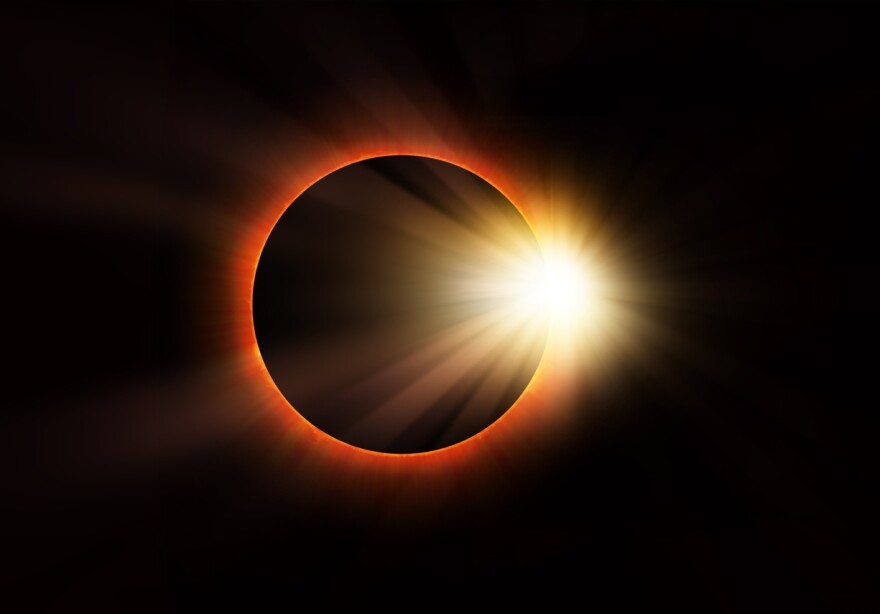On April 8, 2024, a total solar eclipse is expected to sweep across the country. Northern Vermont is in the path of what eclipse fans call "totality," and many people are already planning trips to to watch the eclipse from here.
Here's how Vermonters can prepare for the best viewing next April.
What's gonna happen?
According to Mark Breen, senior meteorologist and planetarium director at the Fairbanks Museum and Planetarium in St. Johnsbury, on the afternoon of April 8, 2024, "the moon basically will go right in front of the sun from our location on the globe."
Breen says for two to three-and-a-half minutes — the amount of time depends on where you're located — the moon will completely cover the sun. It won't happen everywhere in Vermont, mostly in northern and western parts of the state.
When's the last time Vermont's seen a full solar eclipse?
Breen says this is relatively rare, especially for the Burlington area.
"So here in Vermont, the last total eclipse of the sun was back in 1932. And it really was only for the Northeast Kingdom and on into New Hampshire and parts of the Eastern Townships," he said. "So you'd have to go back even earlier — I think it's 1806 — would have been a total solar eclipse for central and southern Vermont, into southern New Hampshire."
Both those eclipses missed Burlington, Breen said. And while he'd have to do some more historical digging to find out the exact year there was a solar eclipse over the Queen City, Breen said that on average, in any given location, 375 years go by between solar eclipses.
Where will people see "totality"?
Breen says the path where the moon will completely cover the sun ("totality") will be 70 to 80 miles wide.
Click here to see NASA's full interactive Google map of the April 8, 2024 solar eclipse.
Breen says the path will basically cover all of the Adirondacks and St. Lawrence Valley, and in Vermont, the top of the area will be around Montreal, and the lower part of the area will run near Middlebury, Montpelier, St. Johnsbury and Bethlehem, New Hampshire.
As for those spots just beyond the line of totality, Breen says the moon will still cover most of the sun.
"So for example, if you go down into southern Vermont, let's just pick Bennington as a location ... the moon will cover 96% of the sun," Breen said. "So there'll be just the hint of a sliver out there, in terms of the sunlight, which can also be a very interesting event, but it's not quite the same as totality."
What's the big deal about "totality"?
Breen says totality can last between one and seven minutes — it's longer the closer you are to the center of the eclipse's path.
And it creates a "very eerie darkness during the middle part of the day."
"It has been reported — and is true — that some birds actually will go to roost at that point," Breen said. "You can see some of the brighter stars, and the planets appear in the sky."
Breen says the total solar eclipse on April 8, 2024 will happen around 3 p.m.
"And you will be seeing this kind of very weird, very unusual thing," he said. "Now, of course, we know what's going on. You know, in modern days, we have all of our scientific work has been done and so forth. But imagine — imagine a few thousand years ago when people really didn't know exactly what was going on. And suddenly, in the middle of the day, the sun disappeared — that was pretty panicky."
How should you view the solar eclipse?
Breen says there are number of organizations, including the Fairbanks Museum, who will be handing out "eclipse glasses."
"And these have been designed as a special filter that allows you to be able to see the sun, because this does present an eye danger," Breen said. "What happens is, even if the sun — just the tiniest bit of the sun, let's just say a little slight slice of the sun is still visible — that is as bright as the entire surface of the sun. So what would happen to your eyes is, if you were to look at it directly, it would burn that curved image into your retina, causing permanent eye damage."
Breen says there are other safe ways to look at the solar eclipse, including using a telescope or a pinhole camera.
Broadcast live on Wednesday, April 12, 2023, at noon; rebroadcast at 7 p.m.
Have questions, comments or tips? Send us a message or check us out on Instagram.





